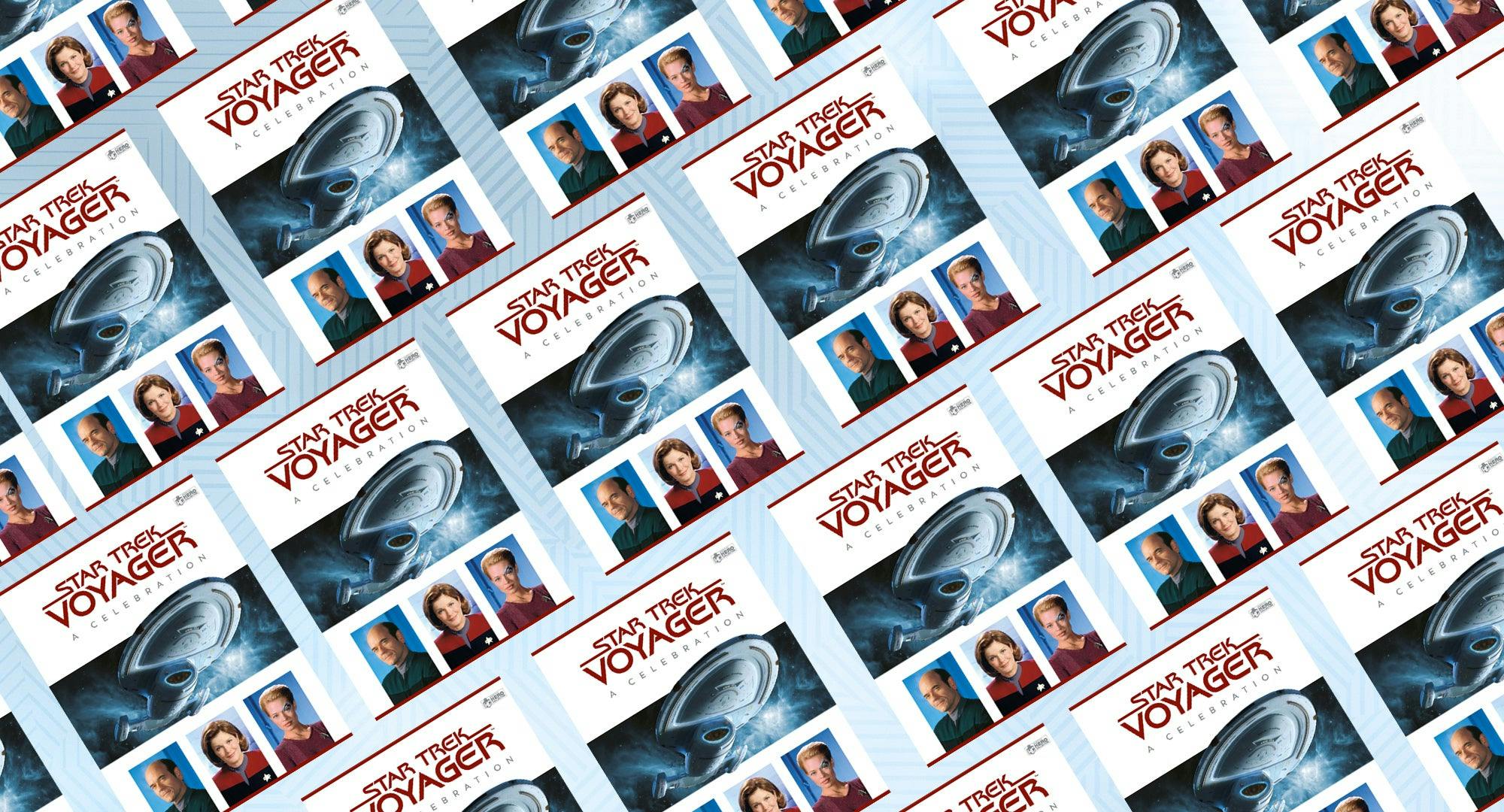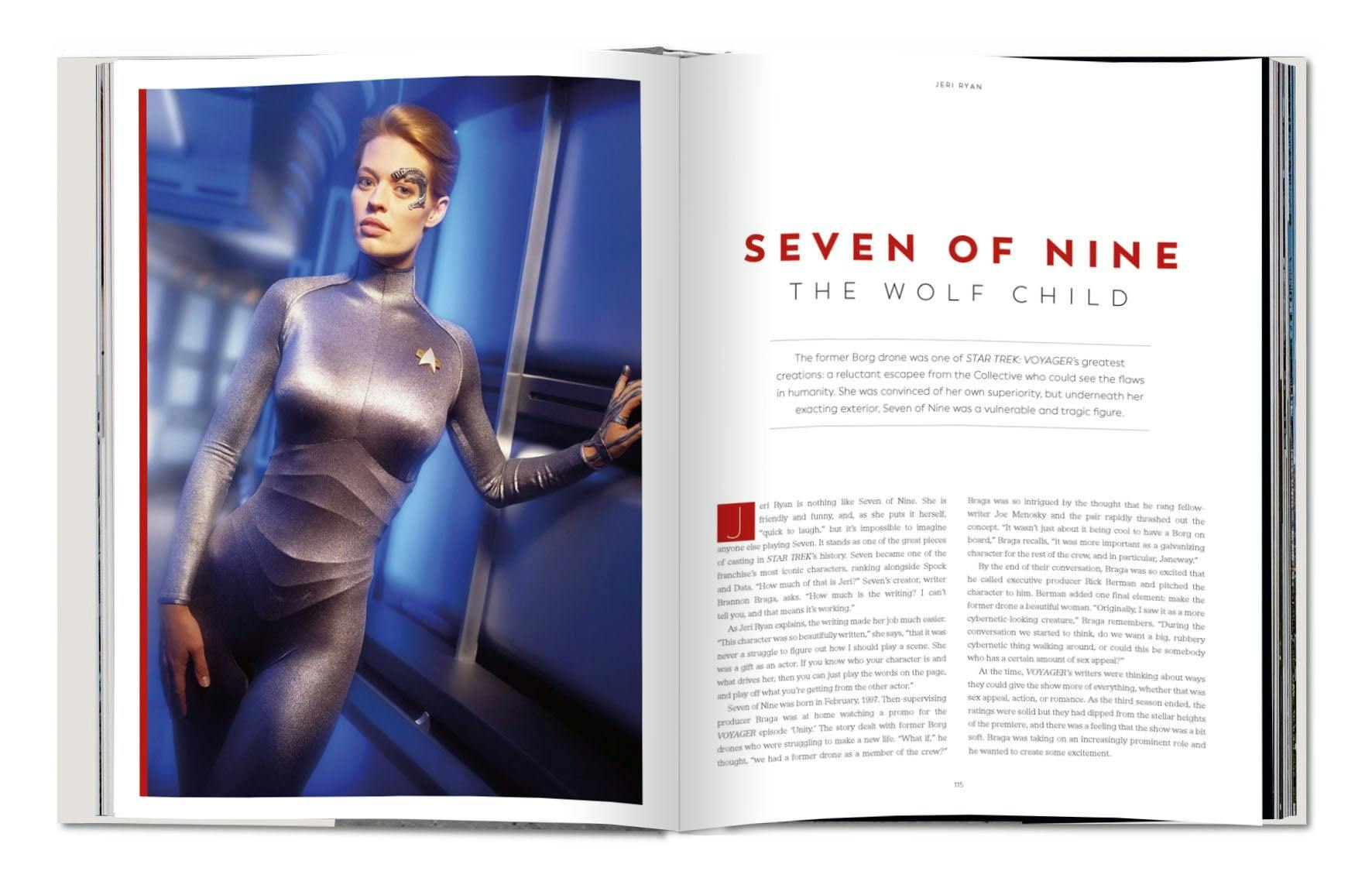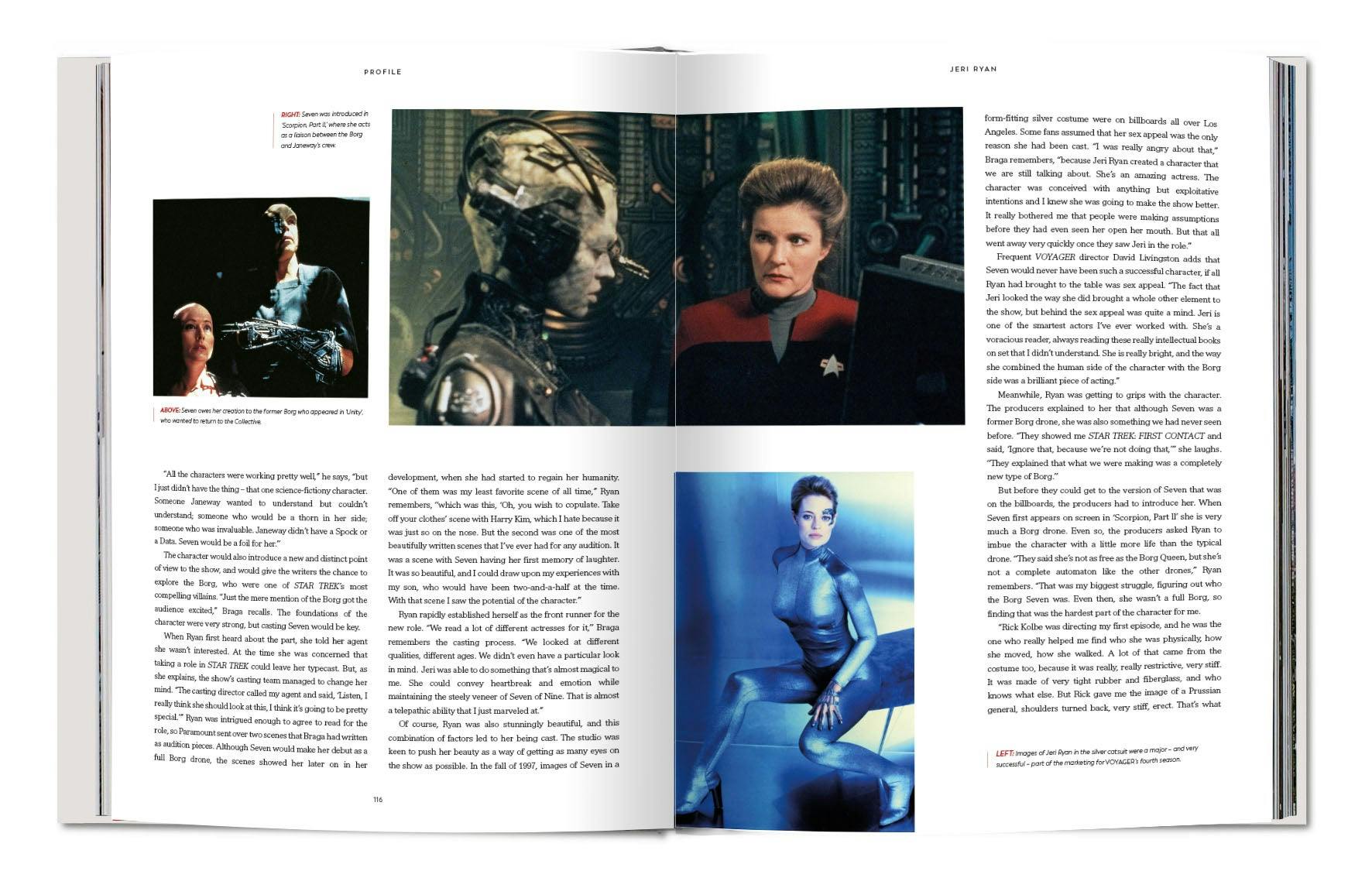Published Nov 17, 2020
EXCERPT: Star Trek: Voyager - A Celebration
Go behind the scenes with Jeri Ryan as the book explores how Seven of Nine came to be.

StarTrek.com
Incredibly, this year is Star Trek: Voyager’s 25th anniversary, and to mark the occasion Hero Collector books are releasing a massive retrospective book called Star Trek: Voyager A Celebration. It’s a hefty tome, that involved more than 30 new interviews, including all the main cast members, and almost every writer and department head. The book is divided into chapters that cover all the main cast members, key episodes, aliens and the work of all the different departments.
StarTrek.com has an exclusive extract to share – an abridged version of the Seven of Nine profile with contributions from Jeri Ryan and Brannon Braga.
Jeri Ryan is nothing like Seven of Nine. She is friendly and funny, and, as she puts it herself, “quick to laugh,” but it’s impossible to imagine anyone else playing Seven. It stands as one of the great pieces of casting in Star Trek’s history, ranking alongside Spock and Data. “How much of that is Jeri?” Seven’s creator, writer Brannon Braga, asks. “How much is the writing? I can’t tell you, and that means it’s working.”
As Jeri Ryan explains, the writing made her job much easier. “This character was so beautifully written,” she says, “that it was never a struggle to figure out how I should play a scene. She was a gift as an actor.”
Seven of Nine was born in February 1997. Then-supervising producer Braga was at home watching a promo for the Voyager episode ‘Unity.’ The story dealt with former Borg drones who were struggling to make a new life. “What if,” he thought, “we had a former drone as a member of the crew?” Braga was so intrigued by the thought that he rang fellow-writer Joe Menosky and the pair rapidly thrashed out the concept. “It wasn’t just about it being cool to have a Borg on board,” Braga recalls, “it was more important as a galvanizing character for the rest of the crew, and in particular, Janeway.”
By the end of their conversation, Braga was so excited that he called executive producer Rick Berman and pitched the character to him. Berman added one final element: make the former drone a beautiful woman. “Originally, I saw it as a more cybernetic-looking creature,” Braga remembers. “During the conversation we started to think, do we want a big, rubbery cybernetic thing walking around, or could this be somebody who has a certain amount of sex appeal?”

StarTrek.com
At the time, Braga was taking on an increasingly prominent role and wanted to create some excitement. “All the characters were working pretty well,” he says, “but I just didn’t have that one science-fictiony character. Someone Janeway wanted to understand but couldn’t understand; someone who would be a thorn in her side; someone who was invaluable. Janeway didn’t have a Spock or a Data.”
The character would also introduce a new and distinct point of view to the show, and would give the writers the chance to explore the Borg, who were one of Star Trek’s most compelling villains.
When Ryan first heard about the part, she told her agent she wasn’t interested. At the time she was concerned that taking a role in Star Trek could leave her typecast. But, as she explains, the show’s casting team managed to change her mind. “The casting director called my agent and said, ‘Listen, I really think she should look at this, I think it’s going to be pretty special.’” Ryan was intrigued enough to agree to read for the role, so Paramount sent over two scenes that Braga had written as audition pieces. “One of them was my least favorite scene of all time,” Ryan remembers, “which was this, ‘Oh, you wish to copulate. Take off your clothes’ scene with Harry Kim, which I hate because it was just so on the nose. But the second was one of the most beautifully written scenes that I’ve ever had for any audition. It was a scene with Seven having her first memory of laughter. It was so beautiful, and I could draw upon my experiences with my son, who would have been two-and-a-half at the time. With that scene I saw the potential of the character.”
Ryan rapidly established herself as the front runner for the new role. “We read a lot of different actresses for it,” Braga remembers. “We looked at different qualities, different ages. We didn’t even have a particular look in mind. Jeri was able to do something that’s almost magical to me. She could convey heartbreak and emotion while maintaining the steely veneer of Seven of Nine. That is almost a telepathic ability that I just marvelled at.”
Of course, Ryan was also stunningly beautiful, and this combination of factors led to her being cast. The studio was keen to push her beauty as a way of getting as many eyes on the show as possible. In the fall of 1997, images of Seven in a form-fitting silver costume were on billboards all over Los Angeles. Some fans assumed that her sex appeal was the only reason she had been cast. “I was really angry about that,” Braga remembers, “because Jeri Ryan created a character that we are still talking about. She’s an amazing actress. The character was conceived with anything but exploitative intentions and I knew she was going to make the show better. It really bothered me that people were making assumptions before they had even seen her open her mouth. But that all went away very quickly once they saw Jeri in the role.”
Meanwhile, Ryan was getting to grips with the character. The producers explained to her that although Seven was a former Borg drone, she was also something we had never seen before. “They showed me Star Trek: First Contact and said, ‘Ignore that, because we’re not doing that,’” she laughs.
But before they could get to the version of Seven that was on the billboards, the producers had to introduce her. When Seven first appears on screen in ‘Scorpion, Part ll’ she is very much a Borg drone. Even so, the producers asked Ryan to imbue the character with a little more life than the typical drone. “They said she’s not as free as the Borg Queen, but she’s not a complete automaton like the other drones,” Ryan remembers. “That was my biggest struggle, figuring out who the Borg Seven was.

StarTrek.com
“Rick Kolbe was directing my first episode, and he was the one who really helped me find who she was physically. A lot of that came from the costume too, because it was really, really restrictive. It was made of very tight rubber and fiberglass, and who knows what else. But Rick gave me the image of a Prussian general, shoulders turned back, very stiff, erect. That’s what her physical presence became.”
By the second episode of the season, Seven had shed most of the Borg costume and become a somewhat reluctant member of the crew. Writer Ken Biller remembers that having her on board instantly suggested dozens of stories. “Once we had the idea that she was separated from her hive, we knew we had to explore that, because the Borg would be trying to get her back, she would want to return to the Borg, she would be struggling with trying to recover her humanity that was lost as a child. Then we could explore in flashback how she became a Borg in the first place. That opened up tons of possibilities.”
The Seven who joined the crew was very much a blank slate. As Ryan says, this didn’t trouble her. As an actress, she didn’t need to know any more than Seven herself did. “There was no benefit to me coming up with some elaborate backstory about what her childhood was like, because she wouldn’t have known that. Her backstory was: she was Borg. That’s all she knew. The only background that I needed to learn was what the Borg are – what drives them.”
As Braga had intended, Seven and her Borg point of view created a new set of dynamics that challenged the other characters, who wanted her to be more human. In his mind, however much Seven acknowledged her humanity, she had been a Borg so long that she could never entirely reject their way of viewing the world.
“To me,” says Braga, “one of the keys to her is that you’ve got Jeri Ryan and everything she brings – this ability to convey this cool, icy character who is brilliant, probably smarter than the whole crew combined. She has been kidnapped, indoctrinated, stripped of her individuality and violated in every sense of the word by the Borg, but she doesn’t see it that way. The key to a good villain is: how do they see themselves? The Borg see themselves as perfection and they have a very good rationale for it. She’s torn. She knows that the Borg are bad, but part of her knows that they are also amazing and there are things she misses about being part of the Collective. She is complex in that way. She’s tragic. She can never go back but she can never really be part of humanity.”
One of the most important things about Seven was that she helped to further redefine Janeway’s character. “The scenes with Janeway were amazing,” Ryan says of working with Kate Mulgrew. “They were some of the richest scenes I got to play. They were two really strong characters, Kate’s a wonderful actress, and it was really fun for those characters to butt heads. It was sort of a mother and unruly teenager really.”
Braga explains that the scenes between them forced Janeway to take a very clear stance on what it meant to be human and had an emotional intensity that was compelling. “That Seven would become a passion project for Janeway was an important dynamic...”

StarTrek.com
...For her part, Ryan was delighted that the conflict was never painted in simplistic terms. “What I loved about the way Seven was written is that they weren’t afraid to show the gray areas. Starfleet and Janeway are not always right and the Borg aren’t always wrong. In the early days there were scenes where she’s pointing out to Janeway: ‘You condemn the Borg for taking my choice away, but now you’ve done the exact same thing.’ Forcibly separating her from the Collective against her will and keeping her from going back to the Collective. That was the same thing that the Borg had done to her, in her mind.”
Biller points out that Seven’s belief in the Borg way of life made her very different from the other members of the crew, who, in accordance with Gene Roddenberry’s vision of the future, were highly evolved and respectful of other cultures. “When you introduce a character like Seven of Nine who thinks she’s superior, of course there is a prejudice. She’s prejudiced against the mere mortals who can’t hold a candle to her. She had so much knowledge from being a Borg. A lot of the best Star Trek characters think they know more than everybody else. That dynamic made the show a lot of fun.”
Seven of Nine’s belief in her own superiority established a link between her and Spock, another iconic Star Trek character who fundamentally believed in the superiority of his own people. “She’s imperious,” Braga says. “I’ll share with you a little trick. I made very sure that Seven of Nine never once asked a question. There was never a line of dialogue with a question mark in it. Everything had to be declarative: ‘State your demand. Explain.’ Seven doesn’t ask questions. She demands answers.”
While the writers were determined that Seven was defined by having been a Borg, it was clear that as the series progressed, she would gradually recover her humanity. How fast this would happen was always a balancing act. “Early on, I think we started to make her too human too quickly,” Ryan says.”So the writers, producers and I, together, kind of went, ‘Ahh, let’s pull this back a little bit, give us somewhere to go.’ There was a steady progression of development that I loved. With every new episode that came out, you learn something new about her or she’s learning something new about humanity. I loved every discovery she made and that I got to go along with her. Especially in my first season, most of the episodes would add another color to the palette. Every piece of background or layer being peeled back gave you another little glimpse into what makes her tick. I think almost every episode there was something like that, that you could add to it that was helpful.”
The idea that Seven of Nine was on a journey to understand her innate humanity was essential to the character’s core. Whenever the writers’ room crafted a story for her, that sense of discovery was at the heart of what they were attempting to achieve. This underlying foundation is what made the character so attractive to Ryan. “With every new episode you learn something new about her,” she says. “I keep saying it was a gift, but truly, that is such a unique, unusual experience as an actor, it really is a gift.”
For Braga, the limits to how much Seven could change were essential to her character. “I always saw Seven as an immovable object. She would try things, but they never worked. When she tried to experiment with emotions and love, there’s a piece of technology in her that will kill her if she falls in love. That’s a great tragedy to me. That episode was called ‘Human Error.’ It was important because it was the moment we realized this was going to be a tragic character. Because if you can’t love, what’s the point of living?”
For Braga that tragedy was essential to the character. When it came to the series finale, he argued that Seven should have died. “I wanted her to sacrifice her life to get the crew home at the end. She was always a tragic character in my mind, which meant she could never change that much. I lost the argument. I still think it would have been a real emotional gut punch. But,” he smiles, “I guess that would have sucked because she would never have been on Picard.”
Star Trek: Voyager A Celebration will be released on November 24 and can be ordered now wherever books are sold.

